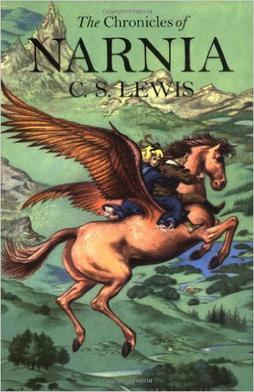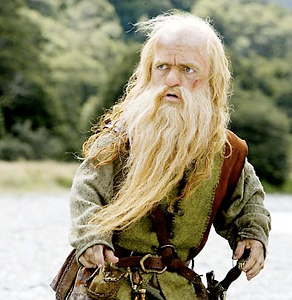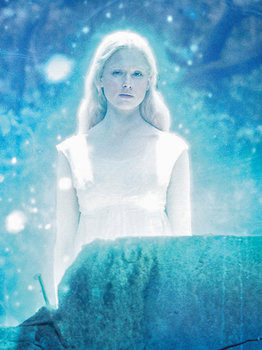
The Chronicles of Narnia is a series of seven high fantasy novels by British author C. S. Lewis. Illustrated by Pauline Baynes and originally published between 1950 and 1956, The Chronicles of Narnia has been adapted for radio, television, the stage, film and video games. The series is set in the fictional realm of Narnia, a fantasy world of magic, mythical beasts and talking animals. It narrates the adventures of various children who play central roles in the unfolding history of the Narnian world. Except in The Horse and His Boy, the protagonists are all children from the real world who are magically transported to Narnia, where they are sometimes called upon by the lion Aslan to protect Narnia from evil. The books span the entire history of Narnia, from its creation in The Magician's Nephew to its eventual destruction in The Last Battle.

The Voyage of the Dawn Treader is a high fantasy novel for children by C. S. Lewis, published by Geoffrey Bles in 1952. It was the third published of seven novels in The Chronicles of Narnia (1950–1956). Macmillan US published an American edition within the calendar year. with substantial revisions that were retained in the United States until 1994. It is volume five in recent editions, which are sequenced according to the novels' internal chronology. Like the other Chronicles of Narnia, The Voyage of the Dawn Treader was illustrated by Pauline Baynes, and her work has been retained in many later editions.

The Silver Chair is a children's fantasy novel by C. S. Lewis, published by Geoffrey Bles in 1953. It was the fourth published of seven novels in The Chronicles of Narnia (1950–1956); it is volume six in recent editions, which are sequenced according to Narnian history. Like the others, it was illustrated by Pauline Baynes and her work has been retained in many later editions.

Peter Pevensie is a fictional character in C. S. Lewis's The Chronicles of Narnia book series. Peter appears in three of the seven books; as a child and a principal character in The Lion, the Witch and the Wardrobe and Prince Caspian, and as an adult in The Last Battle. He is only mentioned in The Horse and His Boy in which he is away on the northern frontier fighting giants and in The Voyage of the Dawn Treader in which he is studying under the tutelage of Professor Kirke.

Edmund Pevensie is a fictional character in C. S. Lewis's The Chronicles of Narnia series. He is a principal character in three of the seven books, and a lesser character in two others.

Eustace Clarence Scrubb is a fictional character in C. S. Lewis's Chronicles of Narnia. He appears in The Voyage of the Dawn Treader, The Silver Chair, and The Last Battle. In The Voyage of the Dawn Treader, he is accompanied by Edmund and Lucy Pevensie, his cousins. In The Silver Chair and The Last Battle, he is accompanied by Jill Pole, a classmate from his school.

Prince Caspian is a fictional character in The Chronicles of Narnia by C. S. Lewis. He is featured in three books in the series: Prince Caspian, The Voyage of the Dawn Treader, and The Silver Chair. He also appears at the end of The Last Battle.
The Chronicles of Narnia is an American film series and media franchise based on The Chronicles of Narnia, a series of novels by C. S. Lewis. The series revolves around the adventures of children in the world of Narnia, guided by Aslan, a wise and powerful lion that can speak and is the true king of Narnia. The children heavily featured in the films are the Pevensie siblings, and a prominent antagonist is the White Witch. The franchise also includes short films, digital series, and video games.

Coriakin is a fictional character in C. S. Lewis's Chronicles of Narnia. He appears in The Voyage of the Dawn Treader.

Trumpkin is a fictional character in C. S. Lewis' fantasy novel series The Chronicles of Narnia. Trumpkin is an intensely practical and skeptical dwarf who lives during the reigns of King Miraz and King Caspian X. He is a major character in Prince Caspian, briefly mentioned in The Voyage of the Dawn Treader, and is a minor character in The Silver Chair.
Aslan's Country is a fictional location from C. S. Lewis' The Chronicles of Narnia series. It is the home of Aslan, the great lion. It is described as a series of mountains, tens of thousands of feet high, but without snow or ice. Instead, Aslan's Country has a clear blue sky, lush green grass, colourful birds, and beautiful trees. There are entrances to Aslan's Country from all worlds, including Narnia and Earth. It is located beyond Narnia's rising sun at the eastern edge of the world, and indeed rings around the whole Narnian world.

Ramandu's daughter, also known as Lilliandil in the 2010 film version of The Voyage of the Dawn Treader, is a fictional character from The Chronicles of Narnia by C. S. Lewis. Introduced in the 1952 book The Voyage of the Dawn Treader, she aids Caspian X and the crew of Dawn Treader to break an enchantment on three of the Seven Great Lords of Narnia. Eventually she becomes Queen of Narnia, after marrying Caspian X, and bears his son, Rilian. In the 1953 novel The Silver Chair, the Lady of the Green Kirtle, in the form of a snake, kills her though she later reappears in the 1956 book The Last Battle. The character appears in multiple adaptations of the book series; the television serial The Chronicles of Narnia, where she is portrayed by Gabrielle Anwar, and The Chronicles of Narnia film series, where Laura Brent plays the role.
Lord Drinian is a fictional character in C. S. Lewis's The Chronicles of Narnia. In The Voyage of the Dawn Treader he is the captain of the Dawn Treader and a close friend of King Caspian X. In The Silver Chair, he has remained a trusted advisor of the king, and has also become a close friend of Caspian's son, Prince Rilian.

The Chronicles of Narnia: The Voyage of the Dawn Treader is a 2010 high fantasy adventure film directed by Michael Apted from a screenplay by Christopher Markus, Stephen McFeely, and Michael Petroni, based on the 1952 novel The Voyage of the Dawn Treader, the third published and fifth chronological novel in the children's book series The Chronicles of Narnia by C. S. Lewis. The sequel to The Chronicles of Narnia: Prince Caspian (2008), it is the third and final installment in The Chronicles of Narnia film series. It is the only film in the series not to be distributed by Walt Disney Studios Motion Pictures, which was replaced by 20th Century Fox. However, Disney would eventually own the rights to all the films in the series following the acquisition of 21st Century Fox by Disney in 2019.
Prince Caspian and The Voyage of the Dawn Treader is the second series of The Chronicles of Narnia that ran from 1988 to 1990. The series, which was shown on BBC television in 1989, is an adaptation of two of C. S. Lewis's The Chronicles of Narnia novels: Prince Caspian (1951) and The Voyage of the Dawn Treader (1952).
The Chronicles of Narnia is a series of seven fantasy novels for children written by C. S. Lewis. It is considered a classic of children's literature and is the author's best-known work, having sold over 100 million copies in 47 languages. Written by Lewis between 1949 and 1954, illustrated by Pauline Baynes and published in London between October 1950 and March 1956, The Chronicles of Narnia has been adapted several times, complete or in part, for television, radio, the stage, film, in audio books, and as video games.
The following outline is provided as an overview of and topical guide to Narnia:

Reepicheep the Mouse is a fictional character in the children's fantasy series The Chronicles of Narnia by C. S. Lewis. He appears as a minor character in Prince Caspian and as a major character in The Voyage of the Dawn Treader, and also briefly at the end of The Last Battle. Reepicheep is a Talking Mouse, the leader of the Talking Mice of Narnia; he is irascible yet imperturbably courteous, utterly without fear, and motivated by a deep concern for honour.
Magical creatures are an important aspect of the fictional world of Narnia contained within The Chronicles of Narnia book series and connected media originally created by C. S. Lewis. Throughout the seven books of the series, the protagonists encounter a variety of these creatures as they travel throughout Narnia and the surrounding lands and seas, including Archenland, Calormen, and the Great Eastern Ocean.












